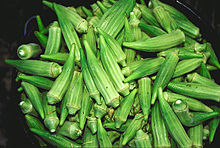Okra
| Okra | |
|---|---|

| |
| Okra leaves, flower buds and young fruit | |
| Scientific classification | |
| Kingdom: | |
| Division: | |
| Class: | |
| Order: | |
| Family: | |
| Genus: | |
| Species: | A. esculentus
|
| Binomial name | |
| Abelmoschus esculentus | |
Okra, or lady's finger (called Bhindi in Indian cuisine), is a flowering plant in the mallow family Malvaceae, originating somewhere near present-day Ethiopia. It was formerly considered a species of Hibiscus, but is now classified in the genus Abelmoschus. The word okra is of African origin and means "lady's fingers" in Igbo, a language spoken in what is now known as Nigeria.
It is an annual or perennial herbaceous plant, growing to 2 m tall. The leaves are 10-20 cm long and broad, palmately lobed with 5-7 lobes. The flowers are 4-8 cm diameter, with five white to yellow petals, often with a red or purple spot at the base of each petal. The fruit is a capsule, 5-20 cm long, containing numerous seeds.
Cultivation and uses

Okra is grown throughout the tropical and warm temperate regions of the world for its fibrous pods full of round, white seeds, which, when picked young, are eaten as a vegetable. It was brought to the United States via the African slave trade route, and can be grown in the southern states as an annual crop. It is also one of the most popular vegetables in late 20th century Japanese cuisine. In Israel, Jordan, Greece and other parts of the eastern Mediterranean, okra, known in Arabic and in Greek as bamia, is widely used in a thick stew made with vegetables and meat. It is also common in Indian cooking where it is either sauteed or added to gravy based preparations.
Okra seeds are normally soaked overnight before planting and then planted 1-2 cm deep when the ground is warm; they will tolerate poor soils with heavy clay and intermittent moisture. Germination ranges from six days (soaked seeds) to three weeks (watered seeds followed by a cool spell). Seedlings require good watering. Okra is among the most heat- and drought-tolerant vegetables in the world; once established, it can survive severe drought conditions.
Okra is normally eaten young as it gets very woody when mature.
Okra leaves are tender and mild to eat. They make a nice addition to salad, and when cooked give a slight okra flavor.
Okra is often steamed until tender, either whole or sliced about 1 cm thick or simply stir-fried. Okra is sometimes used as the thickening agent in gumbo; when cooked, it has the same mucilaginous properties as nopales (the pads of the prickly pear cactus). It is also pickled. In the southern United States it is occasionally breaded and fried or served au gratin.
A pickled Okra pod may be used to replace the olive in a Martini to create an Okratini.
Nutrients
Per 100 grams of Okra (raw or hilaw):
Proximates:
Calories (33 cal.)
Protein (2.0 g)
Carbohydrate (7.6 g)
Total Fat (0.1 g)
Fiber (3.2 g)
Vitamins and Minerals:
Vitamin C (21 mg)
Folate (87.8 mcg)
Vitamin A (660 IU)
Magnesium (57 mg)
See also
Some other food plants have been given common names alluding to their similarities to okra:
More
- FoodsDatabase.com Nutritional information for Okra
